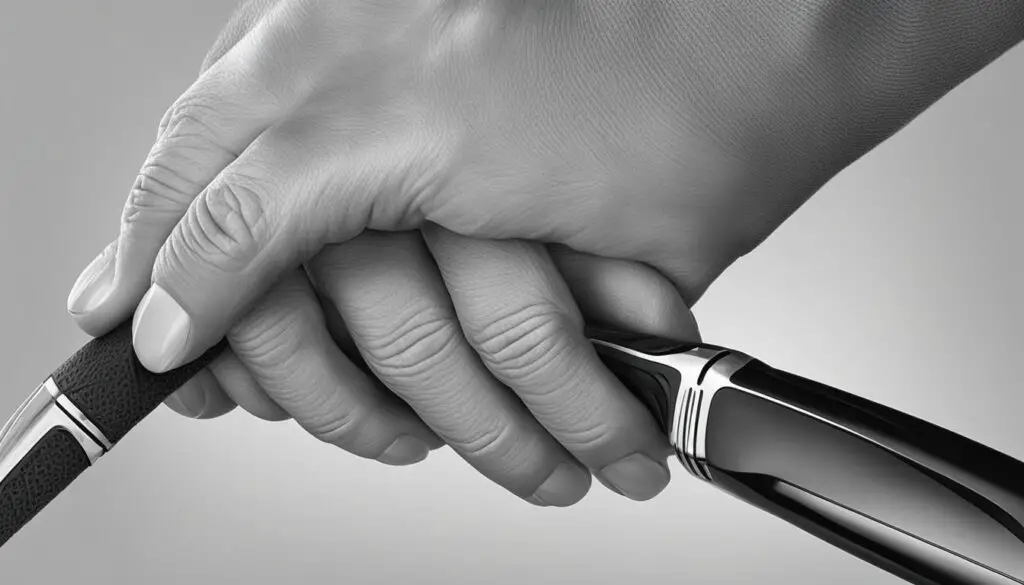Golf is a game of precision, where every aspect of your swing matters. One essential element that can greatly impact your performance is your grip. Golfers have a variety of grip styles to choose from, each with its own advantages. One popular grip style is interlocking the fingers. Interlocking fingers in golf offers several benefits that can improve your swing control and overall game. Whether you’re a beginner or a seasoned pro, understanding why golfers interlock their fingers can greatly enhance your golfing experience.
When it comes to the proper golf grip, interlocking fingers provide a unique advantage. This grip style involves intertwining the little finger of the trailing hand with the index finger of the lead hand. By doing so, golfers can achieve a more secure and connected grip on the club.
Key Takeaways:
- Interlocking fingers in the golf grip provides improved swing control and stability.
- This grip style is favored by many professional golfers.
- Interlocking fingers can be beneficial for players of all skill levels, including beginners.
- By understanding the advantages of interlocking fingers in golf, you can improve your game and achieve better results on the course.
- Proper grip technique and utilizing the interlocking grip can enhance swing control and overall performance.
How to Grip a Golf Club – Step-by-Step Guide to Holding a Golf Club
The grip is one of the most important aspects of a golfer’s game. Properly holding the golf club sets the foundation for a successful swing. One popular grip technique is interlocking the fingers, which can provide better control and stability for beginners.
Here’s a step-by-step guide on how to grip a golf club using the interlocking grip:
- Place the club in the fingers: Hold the club with your lead hand (left hand for right-handed golfers) primarily in the fingers, rather than the palm. This allows for more control and flexibility during the swing.
- Position the lead hand: The lead hand plays a crucial role in controlling the club’s movements. Ensure that the grip is secure but not overly tight. The thumb should be positioned slightly to the right of center on top of the grip.
- Interlock the fingers: With the lead hand in position, rest the little finger of the trailing hand (right hand for right-handed golfers) between the index and middle finger of the lead hand. This interlocked grip provides additional stability and control.
- Position the trailing hand: The trailing hand should also grip the club in the fingers, with the thumb slightly to the left of center on top of the grip. The grip pressure should be similar to that of the lead hand.
- Check hand placement: Ensure that both hands are positioned properly, with the V-shaped formation between the thumb and index finger pointing towards the trail shoulder.
By following these steps, beginners can learn how to grip a golf club using the interlocking grip technique. Remember to practice the grip and experiment with hand placement to find a comfortable and secure grip that works best for you.
Benefits of Interlocking Fingers in Golf
The interlocking grip offers several benefits for golfers, especially beginners. This grip technique provides improved swing control and stability, allowing for more accurate shots. By interlocking the fingers, golfers can maintain a consistent grip pressure throughout the swing, minimizing the chances of the club slipping or twisting.
The interlocking grip is known for reducing tension in the hands, resulting in a smoother and more relaxed swing. This grip style incorporates the larger muscles of the body, promoting better coordination and power.
Additionally, the interlocking grip can be particularly beneficial for golfers with larger hands, as it provides a more secure and comfortable grip on the club. It allows for better clubface control, helping golfers square the club at impact for more precise shots.
Overall, mastering the interlocking grip can significantly enhance a golfer’s swing control and ultimately improve their performance on the course.
Now that you’ve learned how to grip a golf club using the interlocking grip technique, it’s time to put it into practice. Experiment with different grip pressure and hand positioning to find what works best for you. Remember, practice makes perfect, and developing a solid grip is an essential step towards improving your golf game.
Benefits of Interlocking Fingers in Golf
The interlocking grip in golf offers several advantages that can greatly enhance a golfer’s performance on the course.
First and foremost, the interlocking grip provides a firm connection between the hands and the club, allowing for better swing control. This grip style creates a tighter and more secure hold on the club, resulting in increased stability and improved accuracy.
One of the key benefits of using the interlocking grip is its ability to reduce tension in the hands. By interlocking the fingers, golfers can alleviate unnecessary strain and promote a more relaxed swing. This relaxed state enables a smoother and more fluid motion, contributing to greater power and distance in every shot.
Furthermore, the interlocking grip incorporates the entire body into the swing, rather than relying solely on the hands and wrists. This integration of the body’s movements creates a harmonious and coordinated motion, enhancing overall control and generating consistent and powerful shots.
Golfers with larger hands can particularly benefit from the interlocking grip. This grip style provides a better feel and control over the club, allowing for a more confident and effective swing. The interlocking grip ensures that the club remains securely in the hands throughout the swing, reducing the risk of mishits and instilling greater confidence on the course.
While it may take some time to get accustomed to the interlocking grip, its advantages make it a popular choice among golfers of all skill levels. Whether you’re a beginner looking to improve your swing control or an experienced player seeking to enhance your overall performance, the interlocking grip can undoubtedly offer significant benefits on the golf course.

Embrace the interlocking grip and experience the enhanced swing control and improved performance it can bring to your game.
Interlocking Grip for Better Swing Control
The interlocking grip is a technique that can greatly enhance a golfer’s swing control. By interlocking the fingers, players create a more stable connection between their hands and the club. This stability enables them to have better control over the clubface and ensures the ability to square it at impact, resulting in more accurate shots.
One of the key advantages of the interlocking grip is the improvement in grip strength. When the fingers are interlocked, there is a firmer connection with the club, allowing for a more secure grip. This added grip strength translates into increased power and control during the swing, particularly in challenging situations such as strong winds or uneven lies.
It’s essential to maintain a proper golf grip to optimize the benefits of the interlocking grip. The lead hand, which is the left hand for right-handed players, should be positioned on the club with the thumb resting slightly to the right of center. The right hand should then interlock the pinky finger with the index finger of the lead hand, creating a snug and secure grip.
By incorporating the interlocking grip into their game, golfers can significantly enhance their swing control and overall performance on the course. This technique provides the stability and grip strength necessary to execute a more controlled and powerful swing, resulting in improved accuracy and distance.

| Grip Style | Strength |
|---|---|
| Interlocking Grip | Increased grip strength |
| Overlap Grip | Moderate grip strength |
| Ten Finger Grip | Minimal grip strength |
“The interlocking grip has been instrumental in improving my swing control and overall performance on the course. It provides a solid connection between my hands and the club, giving me the confidence to make more accurate shots.” – Luke Johnson, PGA Professional
By mastering the interlocking grip and practicing it consistently, golfers can unlock the potential for better swing control and ultimately improve their game. It is important to note that individual preferences may vary when it comes to grip styles, so players should experiment and choose the grip that feels most comfortable and effective for them.
Conclusion
In conclusion, interlocking the fingers in the golf grip offers numerous benefits for golfers. This grip style, one of the many golf grip styles available, provides improved swing control, stability, and better grip strength. Many professional golfers, such as Tiger Woods and Jack Nicklaus, have used the interlocking grip to great success.
By learning how to grip a golf club properly and utilizing the interlocking grip, golfers of all levels can enhance their game and achieve better results on the course. The interlocking grip allows for a more effective and controlled swing by ensuring a stable connection between the hands and the club.
Not only does the interlocking grip offer better swing control, but it also reduces tension in the hands, allowing for a more relaxed swing. This grip style incorporates the body into the swing rather than relying solely on the hands and wrists, resulting in a more coordinated and powerful swing. Additionally, golfers with larger hands often find the interlocking grip provides a better feel and control over the club.
So, next time you hit the links, consider interlocking your fingers in the golf grip. Explore the benefits of this grip style and experience improved swing control and performance on the course.
FAQ
What is the benefit of interlocking the fingers in the golf grip?
Interlocking the fingers in the golf grip provides improved swing control, stability, and better grip strength.
Is interlocking the fingers in the golf grip suitable for beginners?
Interlocking the fingers can be a suitable option for beginners as it offers improved swing control and stability.
How do I grip a golf club correctly?
To grip a golf club correctly, place it mostly in the fingers rather than the palm of the hands and interlock the fingers.
What are some other golf grip techniques besides interlocking the fingers?
Golfers have different grip techniques to choose from, including overlapping the fingers and the baseball grip.
Is the interlocking grip better than the overlapping grip?
The choice between the interlocking grip and the overlapping grip depends on personal preference. Both grips have their advantages.
Does the interlocking grip reduce tension in the hands?
Yes, the interlocking grip is known for reducing tension in the hands, allowing for a more relaxed swing.
Does the interlocking grip incorporate the body into the swing?
Yes, the interlocking grip incorporates the body into the swing, allowing for more efficient power transfer and control.
Is the interlocking grip beneficial for golfers with larger hands?
Yes, the interlocking grip can be particularly beneficial for golfers with larger hands as it provides a better feel and control over the club.
How does the interlocking grip improve swing control?
The interlocking grip offers a more stable connection between the hands and the club, leading to improved swing control and the ability to square the clubface at impact.
Does the interlocking grip help with grip strength?
Yes, the interlocking grip allows for a firmer connection with the club, enhancing grip strength and control.
